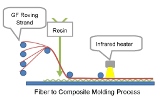 Adeka Corporation, a material manufacturer of chemical and food products, and GH Craft Ltd., a composite structure design, development and evaluation unit of the Teijin Group, have jointly developed the world’s first fiber-to-composite (FtoC) molding process to laminate fiber-reinforced plastics (FRP) in open molds.
Adeka Corporation, a material manufacturer of chemical and food products, and GH Craft Ltd., a composite structure design, development and evaluation unit of the Teijin Group, have jointly developed the world’s first fiber-to-composite (FtoC) molding process to laminate fiber-reinforced plastics (FRP) in open molds.
Adeka and GH Craft will unveil carbon-fiber reinforced plastic (CFRP) samples made with their new FtoC molding process at SAMPE Japan, an international trade fair showcasing the latest advances in materials and processing engineering at Tokyo Big Site from November 29th to December 1st (Booth S-09, East Hall).
The FtoC molding process automates resin impregnating, curing and laminating processes while aligning highly oriented fibers. A special new rapid-curing epoxy resin developed by Adeka enables FRP to be cured in just tens of seconds with GH Craft’s new molding process using infrared radiation. Large-scale equipment such as curing ovens and press molds are not needed because the FRP can be laminated in an open mold. Also, compared to conventional composite production, the FtoC molding process considerably reduces fiber waste by directly molding fibers to the composite without requiring intermediate steps. Moreover, by extending and highly orienting fibers, the process produces glass-fiber-reinforced plastics (GFRP), which offer significantly improved performance, including 100% more bending strength, 40% more tensile strength and 75% more interlayer shear strength compared to conventional GRFP made with conventional resin transfer molding (RTM).
Adeka will develop lineups of specialized resins for the FtoC molding process, and GH Craft will develop practical applications. Adeka and GH Craft will jointly verify the effectiveness of the FtoC molding process through the manufacture of practical products. Furthermore, the companies aim to jointly create a new composite market sector by working to establish the FtoC molding process as a de facto standard for FRP production.
FRP is made of aligned unidirectional fiber that is impregnated with matrix thermoset resin and then molded by heat. Conventional thermoset molding processes, such as autoclave and RTM, have drawbacks including long manufacturing cycles, high production costs, including for large equipment such as curing ovens and press molds needed for large-scale composites, and the need for intermediate trimming steps that produce large amounts of fiber waste. In addition, rather than highly orienting fibers, conventional thermoset molding processes twist the fibers in matrix resin, making it generally difficult to achieve high-tenacity FRP.